Plays From The Distant Past-4
June 28th, 2005
Coaches: Note the similarity of the two plays below to the dive option series from the Split T which came along 30 years later.
A Clever Fake Play
By Dr. Paul Withington, of Harvard,
Head Coach University of Wisconsin
“I should say to the captain of a high school football team, if he came to me and asked for the best play I knew, ‘Make your men learn how to tackle. A team whose members are all good tacklers will be a good team.’
“But here are two offensive plays which are good. The first is a simple line play; the second a fake built on the same play. They go well together.
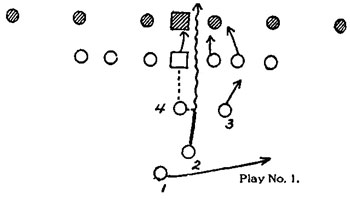
“In the play in Figure 1, the center passes the ball to the quarter, who passes (hands off) to back No. 2, who plunges through between center and guard. No. 3 goes ahead as interference, while 1 makes a bluff to forward pass or run.
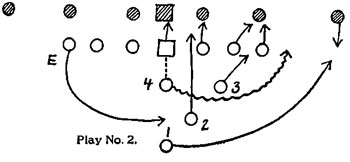
Figure 2
“The second play from the same formation starts as in Figure 1, with the quarter receiving the ball and passing it (faking a hand-off) towards 2, but instead of giving him the ball he withdraws it and conceals it by bending low over it. 2 plunges into the line as if he had the ball. 1 and 3 play as before. The quarter hesitates until the opponents are drawn toward the “fake,” then circles the end with 1 as an interferer. This play may also be made by giving the ball to E, the End, and having him skirt the end instead of the quarterback.”
It’s the Spin That Wins!
Ted Seay
[email protected]
Backfield Stances
June 27th, 2005
From “Functional Football”
By John DaGrosa
W.B. Saunders Company, Publishers
1936
CHAPTER II
Individual Offensive Backfield Fundamentals
Backfield Stances
The backfield stance is a relaxed crouch or semistanding position, behind the line of scrimmage, on balls of both feet, feet being parallel or one behind the other, with comfortable spread of legs to start quickly for blocking and receiving ball, for pass, run or kick. Every backfield should adopt the same stance from the beginning to the end of a game to avoid “telegraphing” — giving their movement or play away. It is important that a perfect stance be obtained at all times in order to obtain speed, power, and drive, which are the objectives of perfect starting.
Whatever type of stance is adopted, the following posture and physical elements are absolutely necessary:
1. Feet spread apart.
2. Weight balanced on balls of feet.
3. Both hands completely relaxed.
4. Ability to move fast in any direction.
5. Quick starts.
6. Split vision.
Types of Stances
Each type of stance has its strong and weak points, advantages and disadvantages. The most popular types follow, with explanations of each:
A. Upright Stance — Back stands erect with hands on hips or extended downward with fingers completely relaxed, weight balanced on balls of foot, or with both hands resting on knees, arms straight and head up.

B. Semi-upright Stance — Back has both knees bent, both parallel to the line of scrimmage and about two feet apart, and both forearms resting across the thighs, with hands and fingers relaxed, weight balanced on balls of feet.
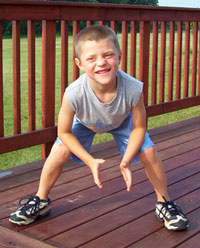
C. Crouch Stance — Back has both knees bent, one hand on ground, other forearm across thigh. Either foot may be slightly back and the weight balanced on balls of feet, rump low.
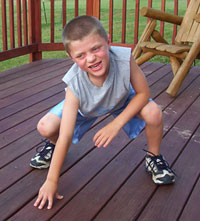
D. Modified Sprint Stance — Back has both knees bent, right leg back, right hand down, left forearm across left thigh. Rump low, weight balanced on balls of feet.
E. Squat Stance — Used only by a back who squats directly behind the center, both hands on respective thighs or on the center’s rump.
Modern football requires backs to work on tackles and ends, and they should therefore, assume a crouch or modified sprint stance to give them the necessary drive, quick starting, and power to take tackles or ends. Backs who are deep enough to be able to receive the ball should use an upright or semi-upright stance, so as to make handling of the ball and running right, left, or forward much easier.
Advantages of the crouch and modified sprint stances are: They force the center to make a low pass which is well hidden and also tend to hide the backs from the secondary, and at the same time produce good drive and a quick start forward.
Disadvantages of the crouch and modified sprint stances are: They make it hard for a back to start fast laterally and also make it much harder to receive and handle the ball. A back is also thrown off balance by the tendency to throw too much weight on the hand that is down. Back, likewise, cannot get a clear view of situation.
All backs should assume perfect stances, observing the following “don’ts”:
1. DON’T lean.
2. DON’T point feet.
3. DON’T look at hole.
4. DON’T look in direction play will go.
5. DON’T take eyes off ball.
6. DON’T change position.
7. DON’T wet fingers to make passes.
8. DON’T concentrate on man to be blocked.
9. DON’T hitch pants when about to receive ball.
10. DON’T dry hands on jersey when about to receive ball.
The advantages of the upright and semi-upright stances are: They give more balance, safer ball handling, faster starting to left or right, more complete relaxation, more ease to pivot on deception plays, better view of teams.
Disadvantages are: Slower starts for backs, secondary gets clear view of backs, passes come up higher.
Snap & Go!
Adam
adam_wesoloski at yahoo.com
Plays From The Distant Past-3
June 13th, 2005
End Run From Punt Formation
by William H. Hollenback, of Pennsylvania,
Head Coach Syracuse University
The run from the kick formation is probably the strongest running play in modern football. The secret of its success lies in getting the line-men into the interference (blocking).
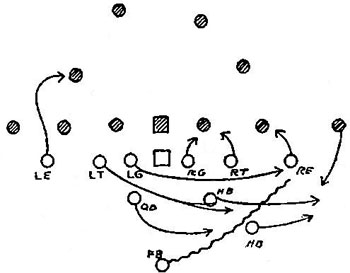
Center passes the ball to the fullback (punter) who runs straight out to the right in order to draw the opposing left end across. The two halfbacks go straight out also. The left half blocks the defensive end out and the right half turns in ahead of the fullback, who also turns in as the defensive end is blocked. On the snap of the ball, the right end blocks the defensive left tackle and the left guard and tackle come out of the line (pull) and turn in just off right tackle. Right guard and tackle block as indicated. Center and left end block and then go through to block defensive secondary defense. It is very important that the right end block the tackle; the left tackle and guard’s speed in getting into the interference is also important to the play. The fullback does not move fast until he turns in between the defensive left tackle and left end. Speed is a big factor in this play.
Next time: The origin of the option???
It’s the Spin That Wins!
Ted Seay
[email protected]